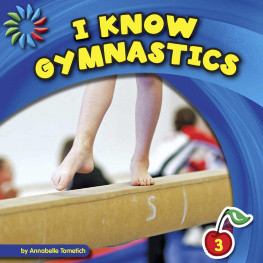Gymnastics Medicine
Evaluation, Management and Rehabilitation
Editor
Emily Sweeney
Department of Orthopedics, University of Colorado School of Medicine, Childrens Hospital Colorado Sports Medicine Center, Aurora, CO, USA
ISBN 978-3-030-26287-7 e-ISBN 978-3-030-26288-4
https://doi.org/10.1007/978-3-030-26288-4
Springer Nature Switzerland AG 2020
This work is subject to copyright. All rights are reserved by the Publisher, whether the whole or part of the material is concerned, specifically the rights of translation, reprinting, reuse of illustrations, recitation, broadcasting, reproduction on microfilms or in any other physical way, and transmission or information storage and retrieval, electronic adaptation, computer software, or by similar or dissimilar methodology now known or hereafter developed.
The use of general descriptive names, registered names, trademarks, service marks, etc. in this publication does not imply, even in the absence of a specific statement, that such names are exempt from the relevant protective laws and regulations and therefore free for general use.
The publisher, the authors, and the editors are safe to assume that the advice and information in this book are believed to be true and accurate at the date of publication. Neither the publisher nor the authors or the editors give a warranty, expressed or implied, with respect to the material contained herein or for any errors or omissions that may have been made. The publisher remains neutral with regard to jurisdictional claims in published maps and institutional affiliations.
This Springer imprint is published by the registered company Springer Nature Switzerland AG
The registered company address is: Gewerbestrasse 11, 6330 Cham, Switzerland
Foreword
Gymnastics is an incredibly diverse sport with unique demands that stretch our routinely held sports medicine principles. Each discipline within gymnastics, described in more detail within this book, presents varied biomechanical demands, injury patterns, return-to-play decision-making, and treatment protocols. This highlights the precise need for this book. Gymnastics Medicine: Evaluation, Management, and Rehabilitation outlines a comprehensive approach to gymnastics sports medicine care.
I have dedicated much of my career to the health and wellness of gymnasts. It has been a tremendous honor to provide care as a member of the USA Gymnastics medical staff. I have traveled with USA Gymnastics as a team physician for domestic and international events, including as their team physician for the 2016 Rio Olympic Games. These opportunities are ones that I do not take for granted. Why do my colleagues and I dedicate so much of our personal and professional time to advance the medical care of gymnasts? We do it because of the passion we have for the sport, we do it for the athletes, and we do it to support our colleagues.
We have a duty as sports medicine practitioners to provide high-quality, compassionate, and ethical care, to the best of our abilities. Education provides a key avenue to developing this high level of care. I am grateful for the hard work Dr. Sweeney and all the authors have put into the publication of this book. This book serves as a broad and comprehensive overview of all the layers of medical care gymnasts deserve. These include epidemiology of injury, biomechanics, injury profiles, treatment, and rehabilitation.
I have had the pleasure to work with Dr. Sweeney during USA Gymnastics events and have known her to be an excellent clinician who exhibits a strong passion for gymnastics medicine. She has worked tirelessly in her own community but also nationally to advance the care of gymnasts, and I cannot think of a better ambassador to bring this compilation of work to the broader community of sports medicine practitioners. It is my honor to write these words of support. I hope that all healthcare professionals who care for gymnasts take the time to read this book. It serves as an excellent roadmap to inform quality of care for this much deserving population of athletes.
David W. Kruse
Huntington Beach, CA, USA
June 18, 2019
Preface
Gymnastics is an amazing sport that encompasses a number of skills and events. To be successful in the sport requires hard work, discipline, excellent time management skills, bravery, and toughness. During my life, I have competed, coached, and judged gymnastics, and now I work as a researcher and pediatric sports medicine physician who frequently cares for gymnasts. I love the sport of gymnastics and am honored to present this medical gymnastics book.
The demands of gymnastics lead to a number of injury patterns and medical conditions. Thus, medical providers who take care of gymnasts should be aware of the unique injuries and issues that face gymnasts. This book provides vital information for physicians, advanced practice providers, physical therapists, athletic trainers, exercise scientists, and mental health professionals who care for gymnasts. By learning more about the nuances of the sport and associated medical issues, the reader will gain an appreciation for the sport and be able to provide better care for all gymnasts. Along with the medical providers noted above, it is my hope that coaches, parents, and gymnasts can also use concepts from this book to decrease injuries and burnout in order to help gymnasts reach their peak potential.
This text covers a number of topics that affect gymnasts. The book starts with an introduction to the history of gymnastics and provides a brief review of the gymnastics disciplines and events. An overview of gymnastics injury epidemiology lays the foundation for the rest of the book. Growth and developmental issues are also covered in this text because many young gymnasts train long hours before or during puberty. Concepts related to the biomechanics of gymnastics, common overuse and acute musculoskeletal injuries, psychological issues, concussions, as well as rehabilitation and return-to-play principles make up the remainder of the book.
This book has been created with the tireless efforts of all of its authors, who are all experts in aspects of gymnastics and sports medicine. Their excellent contributions have made this a comprehensive book that will provide useful information for medical providers and others involved in the care of gymnasts.
In addition to the work of the authors, I must acknowledge a number of other people who assisted in the creation of this book: my parents and siblings who supported my first flips in gymnastics; my gymnastics coaches and teammates; my coworkers at Childrens Hospital Colorado and University of Colorado School of Medicine, who have been supportive of my work in gymnastics; my teachers and mentors in medicine who have helped shape me into the physician I am today; and finally, my husband and son. Without the loving support, patience, and feedback of my husband, Scott, this book would not have been possible. Finally, I must recognize my son, Henry, who has brought me boundless joy and love in such a short time. Henry, I hope you are ready to learn more than you ever wanted about gymnastics!
Over the last three decades, I have learned so much about the sport of gymnastics. It has taught me a number of life lessons that I carry with me today. I hope that, through this text, I am able to provide useful medical educational material and, more importantly, to give others an appreciation for the sport and its athletes.













